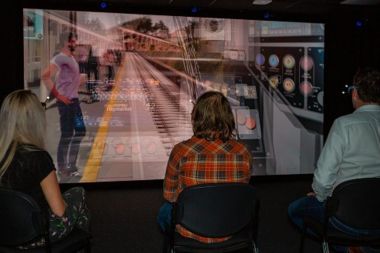Liverpool Uni facility features ‘UK-first’ projection system
ST Engineering Antycip supplied Digital Projection INSIGHT Satellite MLS technology for the country’s first active stereo projection system that can render multiple unique tracked viewpoints.

The Digital Innovation Facility at the University of Liverpool is a new home for academic research into emerging technologies such as autonomous systems, robotics, data analytics and artificial intelligence.
Part of the university’s Institute for Digital Engineering and Autonomous Systems, the £12.7m, 1,500sq metre Digital Innovation Facility comprises research laboratories, immersive visualisation facilities, and work and breakout spaces for academics and collaborative partners.
Motion-capture specialist Target3D, which had been commissioned to build two of the facility’s labs, called on ST Engineering Antycip to supply and configure a projection set-up for the mixed-reality laboratory.
This is a lab which houses the UK’s first active stereo projection system capable of rendering multiple unique tracked viewpoints.
Target3D’s commercial director, Robert Jeffries, says the integrator teamed up with ST Engineering Antycip because of its “knowledge of complex projection and cave automatic virtual environment (CAVE) installations”.
ST Engineering Antycip supplied a Digital Projection INSIGHT Satellite MLS 4K HFR 360 projector to allow lab users to view their own content, from three distinct perspectives, on a floor-to-ceiling, immersive 3D display. The projector features Multi-View technology which, according to ST Engineering Antycip commercial development manager John Mould, “ushers forth a capability that VR display solutions have been desiring since they first emerged: the capability to support ‘true’ collaboration within the virtual world”.
He adds: “The ability for three individuals to be immersed within the same 3D content, and to navigate freely perceiving the visual corrected to their own eyes, means each user is able to point to the same exact location in space and no longer has to share and follow a primary single user.”
The company also equipped the mixed-reality lab – which is home to haptic gloves, VR headsets and a purpose-built spatial sound stage – with two rack-based, 10,000-lumen Satellite MLS modules; three PC-based image generators featuring NVIDIA Quadro RTX 6000 GPUs; a bespoke 5m by 2.63m rear-projection screen; and 30 pairs of Volfoni high-speed 3D glasses. Matt Horwood, from Digital Projection, says the INSIGHT Satellite MLS 4K HFR 360’s compact size, low noise and flexibility solved the logistical challenges presented by a lack of space in the Digital Innovation Facility’s rear projection room. Mould adds: “The Satellite MLS represents a unique opportunity to operate a high-lumens native-4K laser projector without the requirement for 32-amp, single-phase power supply to drive the projection system. This is made possible by the non-traditional approach of dissociating the laser light source from the projector chassis, so the two can be powered separately, enabling standard mains outlets to feed the projection head unit, and the separate laser light modules housed and managed within the equipment rack. “The benefit of this approach is to reduce the resulting operational noise from the projection system, while also removing much of the exhausted heat that requires to be managed. This configuration allows the projection head unit’s physical dimensions to be more compact, addressing different mounting approaches with the full flexibility for orientation.”
As well as having to work around the shortage of space, the ST Engineering Antycip team faced the challenge of the lab being located on the first floor. “It was less accessible for the unloading of large, solid materials,” says Mould. “The room location drove the decision to go with a flexible screen surface that could be transported to the floor level. The end client decided that they required the rear projection space to be physically separated from the main viewing space, which was a decision taken after the contract was awarded, to integrate the screen more effectively. Working with all parties, we managed to find a solution extending the mechanical structures and substrates to provide such a partition.” Horwood says the success of the project is testament to the versatility of the Satellite MLS system, which is ideal for installations where space is at a premium, as well as multi-sided CAVE set-ups. “I can see a multitude of projects benefiting from Digital Projection’s Satellite MLS, especially three- or four-sided CAVEs (Multi-View or standard stereo),” he says. “The RGB laser source also improves the user experience through better colour saturation and uniformity.” Dr Simon Campion, the University of Liverpool’s virtual reality and immersive environments specialist, who manages the mixed-reality laboratory, says: “The Digital Innovation Facility is excited to be home to Europe’s most advanced, large-scale, virtual-reality power wall, which enables multiple participants to simultaneously engage with our visualisations. This is key to the innovative collaborations we facilitate between research and industry across the north west [of England], enabling industry leaders to make clear and informed decisions for improved processes through a collaborative approach.”
Posted: 10th August 2022